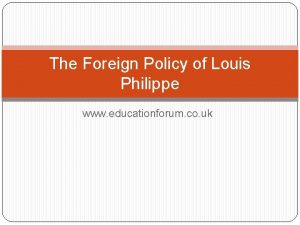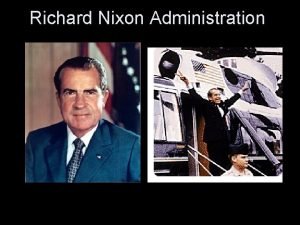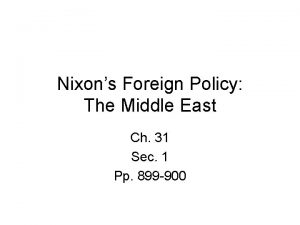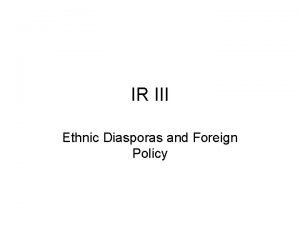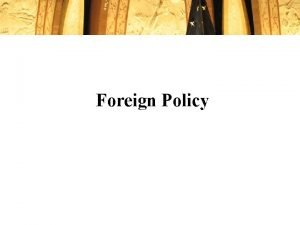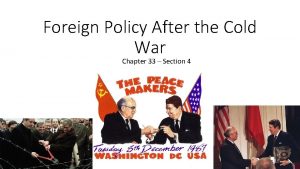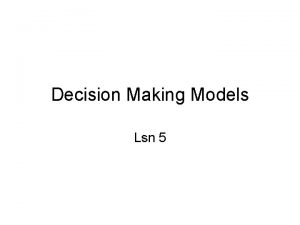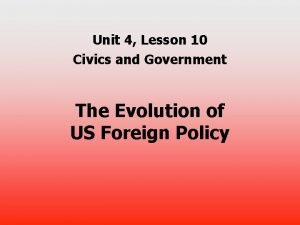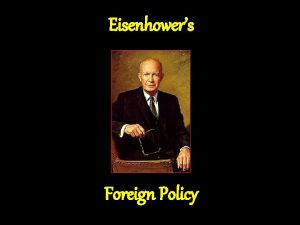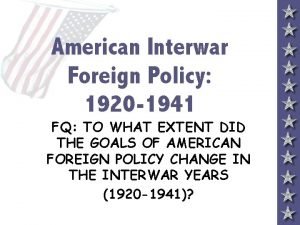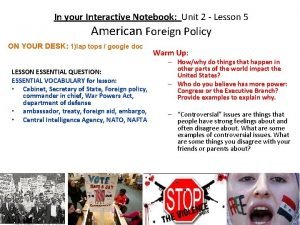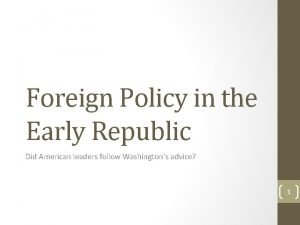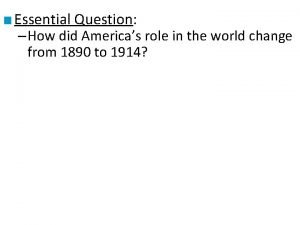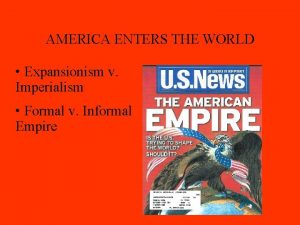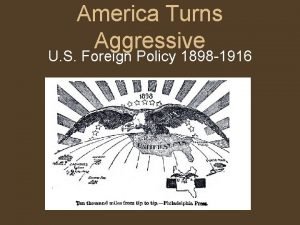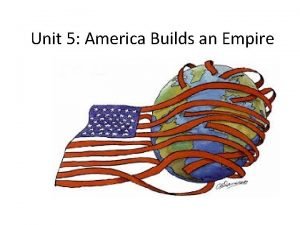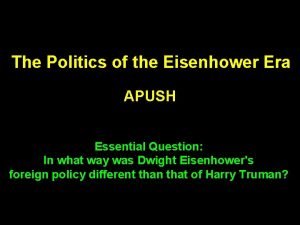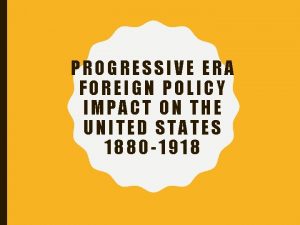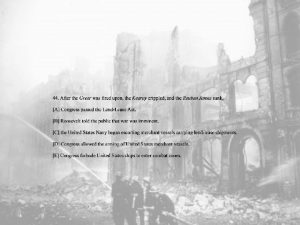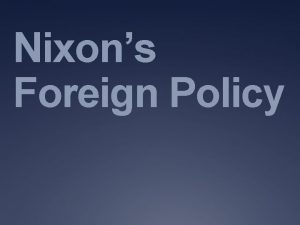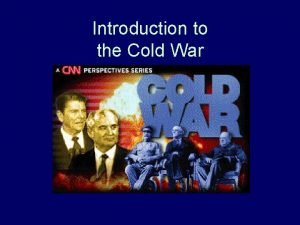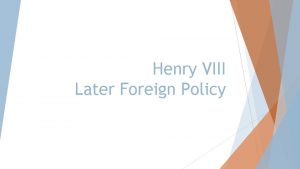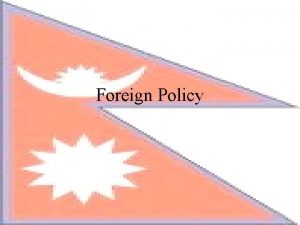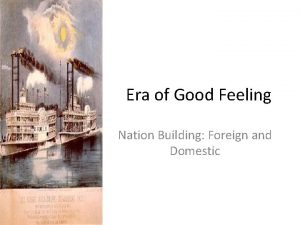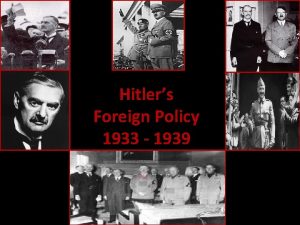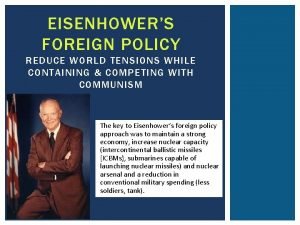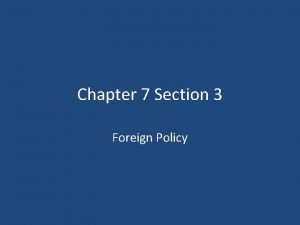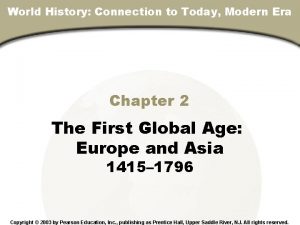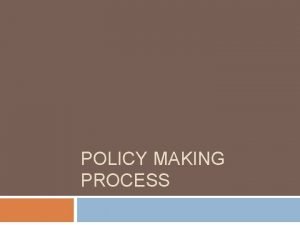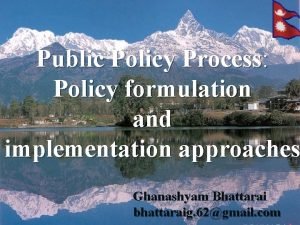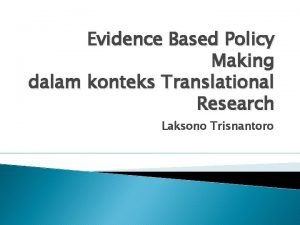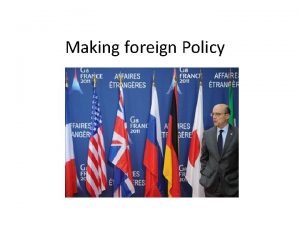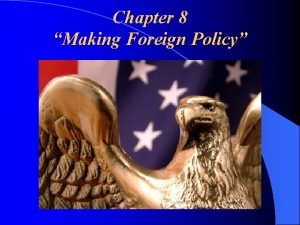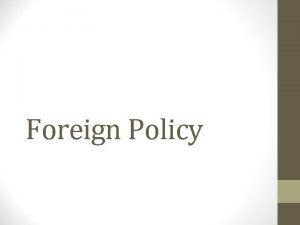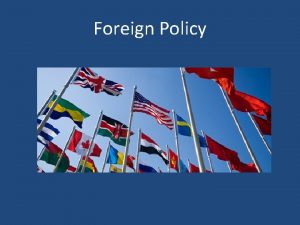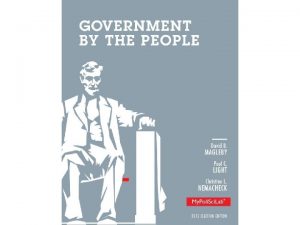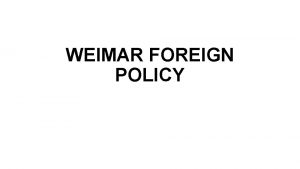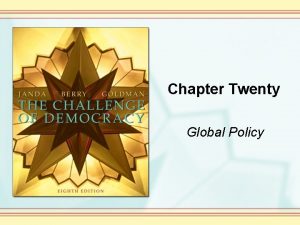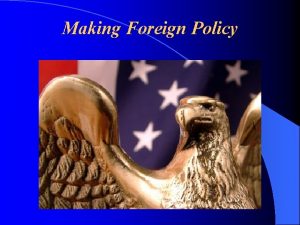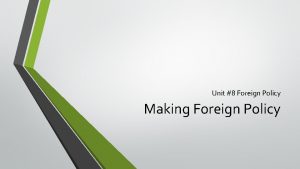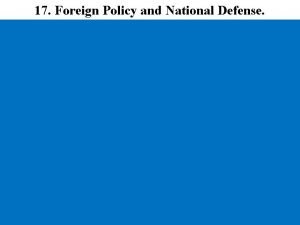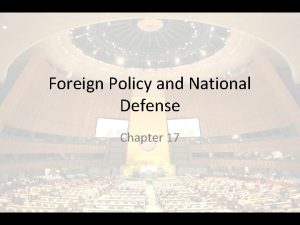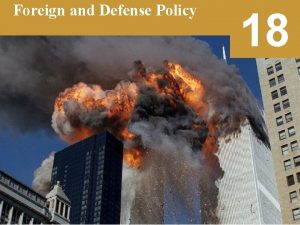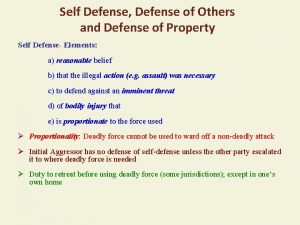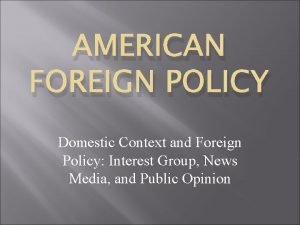Making Foreign and Defense Policy 14 Video The






















































- Slides: 54


Making Foreign and Defense Policy 14

Video: The Big Picture 14 http: //media. pearsoncmg. com/ph/hss/SSA_SHARED_MEDIA_1/pol isci/presidency/Magleby. Brief_Ch 14_Making_Foreign_and_Defense _Policy_Seg 1_v 2. html

Learning Objectives 14 14. 1 Analyze the questions and responses that shape approaches to U. S. foreign policy and defense 14. 2 Assess the status of each of the issues that currently dominate the foreign policy and defense agenda

Learning Objectives 14 14. 3 Outline the structure of the foreign policy and defense bureaucracy 14. 4 Evaluate the options for achieving foreign policy and defense goals

Video: The Basics 14 http: //media. pearsoncmg. com/ph/hss/SSA_SHARED_MEDIA_1/pol isci/presidency/Seg 2_Foreign. Defense_v 2. html

Understanding Foreign Policy and Defense ¤ ¤ ¤ Realism Versus Idealism Isolationism Versus Internationalism Unilateralism Versus Multilateralism Preemption Versus Provocation Hard Power Versus Soft Power 14. 1

Realism Versus Idealism ¤ Viewpoints like realism and idealism attempt to determine other countries’ intentions and motivations n Realism n Aggressive self-interest n Idealism n Collective action benefits ¤ Presidential viewpoints often vary with the individual 14. 1

Isolationism Versus Internationalism ¤ The American Political Debate n Majority of public, Congress supported isolationism until WW II ¤ The role of the U. S. in contemporary geopolitics n The Middle East n UN peacekeeping 14. 1

Unilateralism Versus Multilateralism ¤ U. S. has sufficient military strength to act unilaterally ¤ Advantages to multilateralism n Global good will n Military strategy ¤ United Nations n U. S. action within UN gives it international legitimacy 14. 1

Food Aid 14. 1

Pre-emption Versus Provocation ¤ U. S. responses to provocation n Preemption means attacking first ¤ U. S. pre-emptive acts n The Bush Doctrine n The Iraq War 14. 1

Hard Power Versus Soft Power ¤ Hard power n n Military action Economic sanctions Theory of deterrence Mutually assured destruction (MAD) ¤ Soft power n Diplomacy n Foreign Aid n Influence 14. 1

14. 1 Which of the following suggests that nations will most often act in their own self-interest? a. Isolationism b. Unilateralism c. Idealism d. Realism 14. 1

14. 1 Which of the following suggests that nations will most often act in their own self-interest? a. Isolationism b. Unilateralism c. Idealism d. Realism 14. 1

Explore the Simulation: You Are the 14. 1 President of the United States During a Foreign Policy Crisis http: //media. pearsoncmg. com/long_longman_media_1/2013_ mpsl_sim/simulation. html? simula. URL=20

Video: In Context Seg 3. Foreign. Defense. v 2. mp 4 14. 1

The Foreign Policy and Defense Agenda ¤ ¤ ¤ 14. 2 Addressing Global Climate Change Controlling Weapons of Mass Destruction Fighting Terrorism Negotiating Peace in the Middle East Promoting Free Trade Strengthening Democracy and International Understanding

Camp David 14. 2

Addressing Global Climate Change ¤ Kyoto Protocol n Drew correlation between global warming and greenhouse gases n Ratified by most industrial nations ¤ The U. S. position n Balked at fossil-fuel burning restrictions n Perceived unfair disadvantage to U. S. economy n Did not ratify Kyoto Protocol 14. 2

Controlling Weapons of Mass Destruction ¤ Nuclear non-proliferation since WWII n Diplomatic efforts n Deterrence ¤ Biological and chemical threats n Rogue nations, non-state actors 14. 2

Iran’s nuclear program 14. 2

Fighting Terrorism ¤ Tools n Highly specialized bureaus and agencies within U. S. departments n Intelligence-gathering n Multi-national cooperation ¤ Global spread of terrorist activity 14. 2

Osama Bin Laden 14. 2

Negotiating Peace in the Middle East ¤ U. S. role in Middle East since 1948 ¤ Middle East and Oil ¤ Arab Spring 14. 2

Promoting Free Trade ¤ U. S. supports global free-trade efforts ¤ Trade with China n Ideological Antagonism and Rights abuses n U. S. maintains normal trade relations 14. 2

Strengthening Democracy and International Understanding ¤ The geo-strategy of democracy n Cold War containment n Current role in global security ¤ Humanitarianism n Peace Corps n Foreign Aid 14. 2

Peace Corps 14. 2

14. 2 Which of the following best illustrates U. S. defense policy? a. Deterrence b. Preemption c. Both of the above d. Neither of the above 14. 2

14. 2 Which of the following best illustrates U. S. defense policy? a. Deterrence b. Preemption c. Both of the above d. Neither of the above 14. 2

Video: In the Real World 14. 2 http: //media. pearsoncmg. com/ph/hss/SSA_SHARED_MEDIA_1/pol isci/presidency/Seg 5_Foreign. Defense_v 2. html

The Foreign Policy and Defense Bureaucracy ¤ ¤ The National Security Council The State Department Intelligence Agencies The Department of Defense 14. 3

The National Security Council 14. 3 ¤ Closely advises president at highest level of foreign policy n Most senior-level security officials in government n NSC is most visible foreign policy body ¤ Structure n Created by National Security Act 1947 n Subject to regulation n Inclusion of V. P. , Secretaries of Defense & State

The State Department ¤ Duties n U. S. global presence at state-to-state level n Protection of U. S. citizens ¤ The Foreign Service n Culture of Bureaucracy ¤ The increasing role of the State Dept. since WWII 14. 3

9/11 Commission 14. 3

Intelligence Agencies 14. 3 ¤ The Central Intelligence Agency n Most prominent intelligence-gathering U. S. agency ¤ The Broader Intelligence Community n BIR, DIA, FBI, etc. n Reporting, analysis, and dissemination of vital information

The Department of Defense ¤ The Joint Chiefs of Staff ¤ The All–Volunteer Force ¤ Contractors 14. 3

14. 3 Which of the following is comprised of the respective heads of the Armed Forces? a. The Central Intelligence Agency b. The Joint Chiefs of Staff c. The Foreign Service d. The National Security Council 14. 3

14. 3 Which of the following is comprised of the respective heads of the Armed Forces? a. The Central Intelligence Agency b. The Joint Chiefs of Staff c. The Foreign Service d. The National Security Council 14. 3

Explore Foreign and Defense Policy: How Much Does America Spend on Defense? 14. 3 http: //media. pearsoncmg. com/long_magleby_mpslgbp_brief 10 /pex 14. html

Foreign Policy and Defense Options ¤ ¤ ¤ Conventional Diplomacy (Soft Power) Public Diplomacy (Soft Power) Foreign Aid (Soft Power) Economic Sanctions (Soft Power) Military Action (Hard Power) 14. 4

Video: Thinking Like a Political Scientist 14. 4 http: //media. pearsoncmg. com/ph/hss/SSA_SHARED_MEDIA_1/pol isci/presidency/Seg 4_Foreign. Defense_v 2. html

Voting in Egypt 14. 4

Conventional Diplomacy (Soft Power) ¤ Formal communications between States n Embassies, ambassadors, and officials of state n “Breaking” diplomatic relations ¤ The United Nations (UN) n The UN Security Council 14. 4

Public Diplomacy (Soft Power) ¤ U. S. seeks to improves its global image ¤ The increasing role of media influence ¤ U. S. propaganda efforts n Voice of America n Campaign of Truth 14. 4

Foreign Aid (Soft Power) ¤ Provides the U. S. with foreign policy options ¤ Foreign aid is politically unpopular at home n About 1% of federal budget used on foreign aid n Most aid subsidizes U. S. businesses 14. 4

Economic Sanctions (Soft Power) ¤ Sanctions yield mixed results n South Africa, Libya n Cuba, Iran ¤ Sanctions affect all economies n Targeted regimes n U. S. domestic n International 14. 4

Military Action (Hard Power) ¤ U. S. has used military action regularly since 1789 ¤ U. S. military role as superpower n Lessons of Vietnam ¤ Tactical considerations n Conventional superiority n Covert Ops 14. 4

TABLE 14. 1: Costs of War 14. 4

14. 4 About how much of the U. S. federal budget is spent on foreign aid? a. 1% b. 5% c. 12% d. 29% 14. 4

14. 4 About how much of the U. S. federal budget is spent on foreign aid? a. 1% b. 5% c. 12% d. 29% 14. 4

Discussion Question 14 Is U. S. foreign policy headed in the right direction? Why not? What are some of the hallmarks of U. S. foreign policy in the last 50 years?

Video: So What? 14 http: //media. pearsoncmg. com/ph/hss/SSA_SHARED_MEDIA_1/pol isci/presidency/Magleby. Brief_Ch 14_Making_Foreign_and_Defense _Policy_Seg 6_v 2. html

Further Review: On My. Poli. Sci. Lab ¤Listen to the Chapter ¤Study and Review the Flashcards ¤Study and Review the Practice Tests 14
 So here you are too foreign for home
So here you are too foreign for home Th and tc cells
Th and tc cells 1790 foreign policy
1790 foreign policy Foreign policy of louis philippe
Foreign policy of louis philippe What was thomas jefferson foreign policy
What was thomas jefferson foreign policy Nixons foreign policy
Nixons foreign policy Nixons foreign policy
Nixons foreign policy Actors in foreign policy
Actors in foreign policy Definition of foreign policy by scholars
Definition of foreign policy by scholars Chapter 33 section 4 foreign policy after the cold war
Chapter 33 section 4 foreign policy after the cold war Actors in foreign policy
Actors in foreign policy Unit 4 lesson 10 american foreign policy
Unit 4 lesson 10 american foreign policy Truman foreign policy vs eisenhower
Truman foreign policy vs eisenhower Interwar america
Interwar america Lesson 5: american foreign policy
Lesson 5: american foreign policy Hitler's foreign policy timeline
Hitler's foreign policy timeline Foreign policy in the early republic
Foreign policy in the early republic Foreign policy imperialism
Foreign policy imperialism Foreign policy imperialism
Foreign policy imperialism Andrew johnson foreign policy
Andrew johnson foreign policy President taft’s foreign policy emphasized
President taft’s foreign policy emphasized Foreign policy
Foreign policy Eisenhower doctrine apush
Eisenhower doctrine apush Pros and cons of big stick diplomacy
Pros and cons of big stick diplomacy Foreign policy shift
Foreign policy shift Nixons vietnamization policy
Nixons vietnamization policy Conclusion of cold war
Conclusion of cold war Henry viii foreign policy 1509-1529
Henry viii foreign policy 1509-1529 Foreign policy
Foreign policy What is foreign policy analysis
What is foreign policy analysis Whats the era of good feelings
Whats the era of good feelings When was the league of nations created
When was the league of nations created Eisenhowers foreign policy
Eisenhowers foreign policy Foreign policy vocabulary
Foreign policy vocabulary Chapter 14 section 1 the search for spices
Chapter 14 section 1 the search for spices Foreign policy apush
Foreign policy apush Isolationism antonym
Isolationism antonym War making and state making as organized crime
War making and state making as organized crime Yandex search video
Yandex search video Yahoo gravity
Yahoo gravity Tw.search.yahoo.com
Tw.search.yahoo.com The frame size of a video refers to the video’s
The frame size of a video refers to the video’s Virtual insanity analysis
Virtual insanity analysis Policy adoption
Policy adoption The policy making process
The policy making process Public policy steps
Public policy steps Evidence based policy making adalah
Evidence based policy making adalah Is making inference simply making a guess
Is making inference simply making a guess Hình ảnh bộ gõ cơ thể búng tay
Hình ảnh bộ gõ cơ thể búng tay Ng-html
Ng-html Bổ thể
Bổ thể Tỉ lệ cơ thể trẻ em
Tỉ lệ cơ thể trẻ em Chó sói
Chó sói Glasgow thang điểm
Glasgow thang điểm Alleluia hat len nguoi oi
Alleluia hat len nguoi oi



